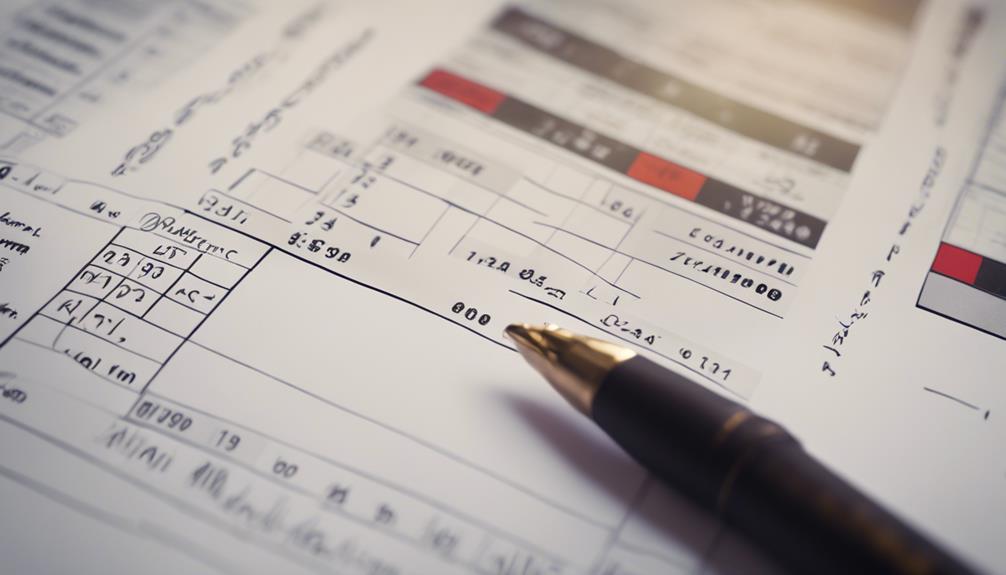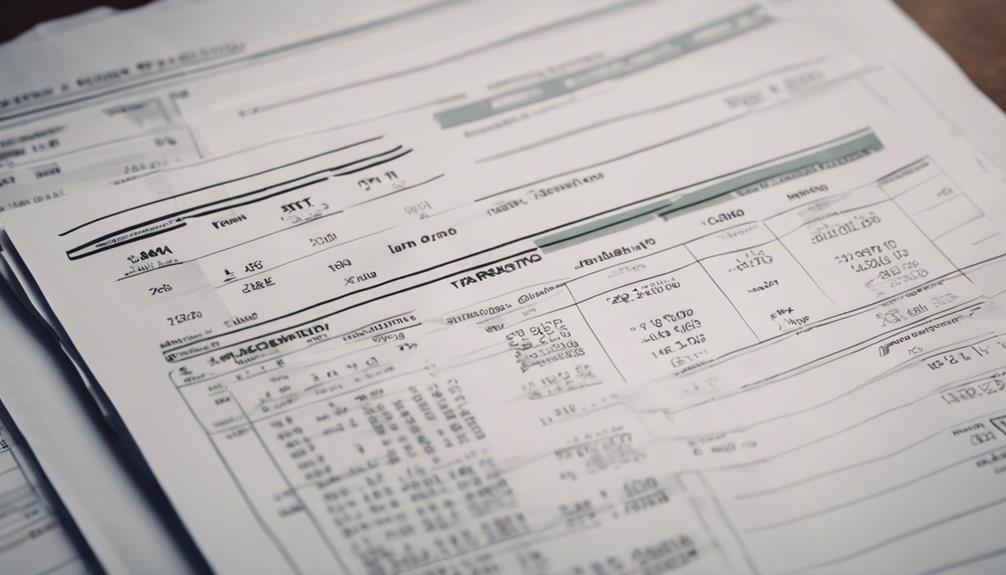Double-entry accounting forms the cornerstone of financial precision, accurately reflecting an entity's financial status by meticulously recording transactions with debits and credits. Each entry impacts at least two accounts, maintaining consistency and ensuring completeness for precise and verifiable records. This system guarantees that assets equal liabilities plus equity, aids in error detection, and facilitates detailed financial reporting. To implement this method effectively, establish clear charts of accounts, train staff, utilize accounting software, and conduct regular account reconciliations with a meticulous approach. Elevate financial accuracy and transparency through double-entry accounting. Further insights await on its advantages and best practices.
Key Takeaways
- Ensures assets equal liabilities plus equity for financial balance.
- Facilitates error detection through reconciliation processes.
- Provides a comprehensive view of a company's financial status.
- Enables the generation of detailed financial reports for informed decisions.
- Enhances financial accuracy and transparency significantly.
Importance of Double-Entry Accounting

Double-entry accounting stands as a cornerstone of financial precision, ensuring a thorough and accurate representation of a company's financial health. By requiring every transaction to be recorded with both a debit and a credit, double-entry accounting provides a complete view of a company's financial standing.
Debits signify increases in assets or expenses, while credits indicate decreases in liabilities or revenues. This meticulous recording system guarantees that assets always equal liabilities plus equity, offering a clear picture of the financial status.
Compared to single-entry accounting, which only records transactions in a single account, double-entry accounting is considered more accurate and reliable, making it essential for businesses aiming for financial clarity and compliance with accounting standards.
Key Principles of Double-Entry System

Moving from the significance of double-entry accounting, an exploration of the key principles governing this system reveals the foundation of financial precision and transparency.
- Dual Aspect: Each transaction affects at least two accounts, maintaining the balance between debits and credits.
- Consistency: Entries must follow the same structure consistently, ensuring accuracy and comparability.
- Completeness: Every transaction must be recorded, leaving no gaps or omissions in the financial records.
- Accuracy: Entries should be precise and verifiable, guaranteeing the reliability of the financial information presented.
Advantages of Double-Entry Accounting

Implementing a double-entry accounting system enhances financial accuracy and transparency in business operations. By mandating that every transaction be recorded as both a debit and a credit, this method guarantees that assets always equal liabilities plus equity.
The benefits of double-entry accounting include increased precision in financial records, the ability to detect errors more easily through reconciliation processes, and providing a thorough view of a company's financial health. This system also enables businesses to generate detailed financial reports and statements, aiding in decision-making processes and strategic planning.
Implementing Double-Entry for Precision

To achieve financial precision and accuracy in business operations, companies must adopt a meticulous approach to recording transactions. Implementing double-entry accounting guarantees a robust financial tracking system that minimizes errors and provides a thorough view of the company's financial health.
Here are some key steps to implement double-entry accounting effectively:
- Establish Clear Chart of Accounts: Define categories for transactions to organize financial information systematically.
- Train Staff on Double-Entry Principles: Make sure all team members understand the concept of debits and credits for accurate recording.
- Utilize Accounting Software: Invest in reliable software to streamline the double-entry process and reduce manual errors.
- Regularly Reconcile Accounts: Conduct frequent reconciliations to identify discrepancies and maintain accurate financial records.
Double-Entry Accounting Best Practices

Effective utilization of double-entry accounting hinges on adhering to established best practices in financial record-keeping.
One key practice is maintaining a consistent chart of accounts to classify transactions accurately. Reconciling accounts regularly guarantees accuracy and detects errors promptly.
Segregating duties among employees reduces the risk of fraud and errors. Utilizing accounting software with built-in controls enhances efficiency and reduces manual errors.
Implementing internal controls, such as approval processes for transactions, safeguards financial data. Documenting all transactions thoroughly provides a clear audit trail for reference.
Frequently Asked Questions
What Are the Consequences of Not Using Double-Entry Accounting?
Not using double-entry accounting can lead to inaccuracies in financial records. Without the checks and balances of debits and credits, errors may go unnoticed, affecting the overall financial health of a business.
This method lacks the precision and completeness that double-entry accounting provides. It's essential to implement a system that guarantees accurate tracking of transactions to make informed decisions and maintain financial stability.
How Does Double-Entry Accounting Prevent Errors and Fraud?
Double-entry accounting prevents errors and fraud by necessitating every transaction to be recorded with corresponding debits and credits. This meticulous process guarantees accurate financial tracking as each entry is cross-checked for consistency.
Can Double-Entry Accounting Be Used for Personal Finances?
Double-entry accounting can be used for personal finances, offering a structured way to track income and expenses accurately. By recording transactions as debits and credits, individuals can gain a complete view of their financial situation.
This method guarantees balance in assets and liabilities, aiding in financial management and decision-making. While more complex than single-entry systems, double-entry accounting provides a precise way to monitor personal finances effectively and maintain financial health.
Is Double-Entry Accounting Required by Law for All Businesses?
Double-entry accounting isn't required by law for all businesses. While it's a fundamental accounting process that offers precision and thorough financial insights, some small businesses may opt for single-entry accounting due to its simplicity and ease of use. Larger businesses commonly use double-entry accounting as it's essential for creating detailed financial statements.
Businesses should choose the system that best suits their needs and financial reporting requirements.
Are There Software Tools Available to Simplify Double-Entry Accounting?
Software tools exist to simplify double-entry accounting, aiding businesses in managing financial transactions efficiently. These tools streamline the recording process, ensuring accuracy and compliance.
Users can benefit from features like automated journal entries, customizable reports, and real-time monitoring of financial data. By leveraging such tools, organizations can enhance their accounting practices, improve decision-making, and maintain precise financial records.
Choose software that aligns with your business needs for best results.
Conclusion
To wrap up, although single-entry accounting may appear simpler, the precision and accuracy provided by double-entry accounting far outweigh any perceived convenience.
By meticulously recording every transaction through debits and credits, businesses can guarantee a more thorough financial overview.
Addressing concerns about the complexity of double-entry accounting, it's crucial to bear in mind that the advantages of this system ultimately lead to better decision-making and financial management, instilling confidence in the accuracy of financial records.










